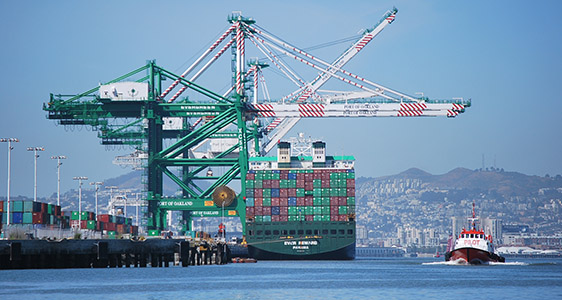Port of Oakland cargo volume posted dramatic declines in January, the result of an ongoing West Coast waterfront labor dispute.

Total volume in January at the Port of Oakland was down by 32 percent compared to last year. The port attributed the decline to the slowdowns that occurred during a dispute between dockworkers and employers over a new contract. Photo by Joel Williams
By Patrick Burnson
Published: March, 2015
Port of Oakland cargo volume posted dramatic declines in January, the result of an ongoing West Coast waterfront labor dispute. The port reported today that containerized imports were down 39 percent from January 2014. Exports declined 26 percent, and total volume was off 32 percent.
The port attributed the decline to slowdowns arising from a dispute between dockworkers and employers over a new contract. Port operations at 29 West Coast ports have been affected by the impasse, now entering its ninth month.
“With a decline in productivity and a breakdown in vessel schedules at all U.S. West Coast ports, cargo volumes are far from normal,” said Port of Oakland Maritime Director John Driscoll.
The port said that importers have begun diverting containerized cargo to gateways outside the West Coast. These include ports in Canada, Mexico and the East Coast. It added that exporters have been challenged in shipping cargo to overseas markets because of vessel delays and diversions.
Navis World Conference Coming to San Francisco
From March 29 to April 1, Oakland-based Navis will once again host the world’s leading marine container terminal operators in San Francisco for Navis World, a three-day biennial customer conference that brings together more than 300 marine terminal executives, directors, managers and IT personnel from around the world.
This 10th Navis World will engage participants on the latest advancements in technologies and processes to improve terminal productivity and efficiency. Sessions and activities will focus on the Navis World conference theme: “Connect, Collaborate, Innovate.” For more information, see navis.com.
Transpacific Carriers Propose Rate Hike
The first sign of rate-hike behavior was evident this month when Transpacific Stabilization Agreement (TSA) carriers recommended a GRI of $600 per 40-foot container (FEU) increase in rates across the board.
“The transpacific freight market is maturing,” said TSA Executive Administrator Brian Conrad. “We should not continue to measure it against double-digit annual growth seen a decade ago, but rather in the context of a healthy, steadily improving trade.” He added that, similarly, the excess vessel supply reported globally is often overstated in the transpacific market because it does not take into account infrastructure and other operational constraints.
“The primary imbalance in the transpacific is not so much one of supply versus demand,” Conrad said, “but rather one of costs versus revenue, that in turn drives service.”
Container lines are also forecasting significant increases in shoreside and inland rail, truck and equipment management costs during 2015 and beyond as demand remains strong, cargo and equipment imbalances widen, and locomotive, truck and equipment shortages in key locations push up rates. These conditions reflect long-term operational challenges separate from the prolonged labor problems that have made some carriers reconfigure their deployments away from the West Coast.
No promise of increased reliability can be assured by carriers, however. The latest data shows that the aggregate on-time performance for the transpacific, Asia-Europe and transatlantic trades dropped to 58 percent in 2015 down from 64 percent year-to-date, according to the London-based consultancy Drewry Supply Chain Advisors.
“The slower-demand winter season should ease some of the congestion pressures and allow for some improvement in container shipping reliability,” said Simon Heaney, senior manager of supply chain research at Drewry. “Falling bunker prices should also help raise the on-time performance as carriers will face a lower fuel bill for speeding up ships that fall behind schedule.”
However, the introduction of new alliance service networks in 2015 is a short term risk-to-reliability as new schedules are phased in, said Heaney. “From a shipper’s perspective, it’s good to have a broad portfolio of carriers to pick from,” he said.
Patrick Burnson is the past president and current board member of the Pacific Transportation Association, based in San Francisco. www.pacifictrans.org

